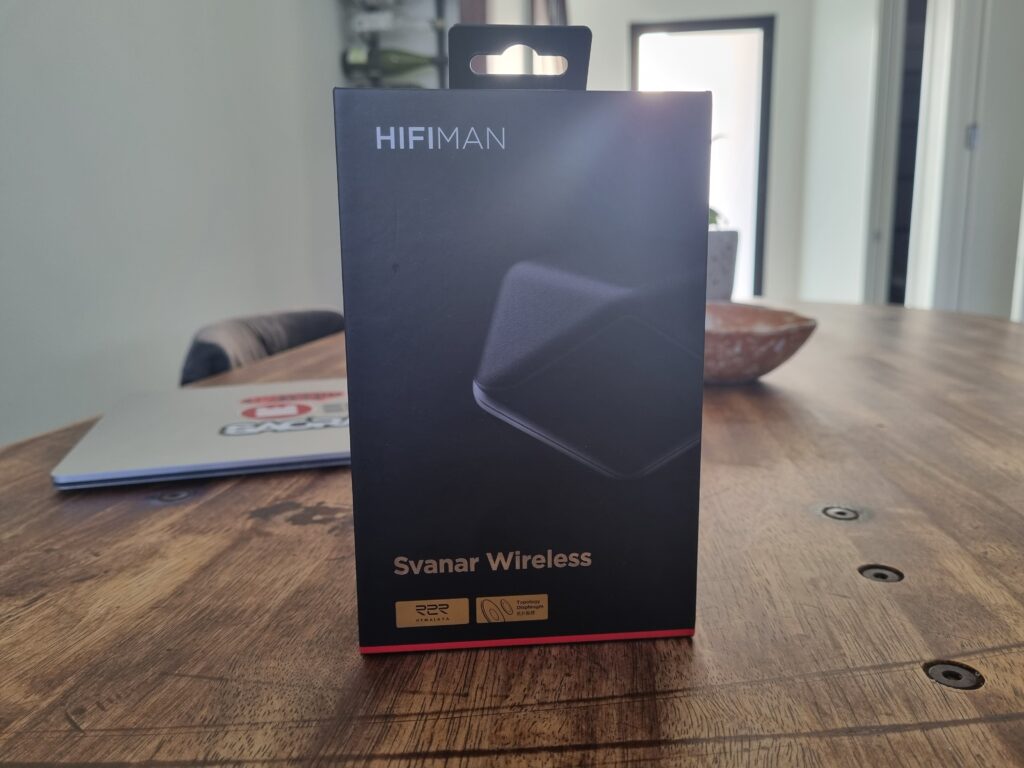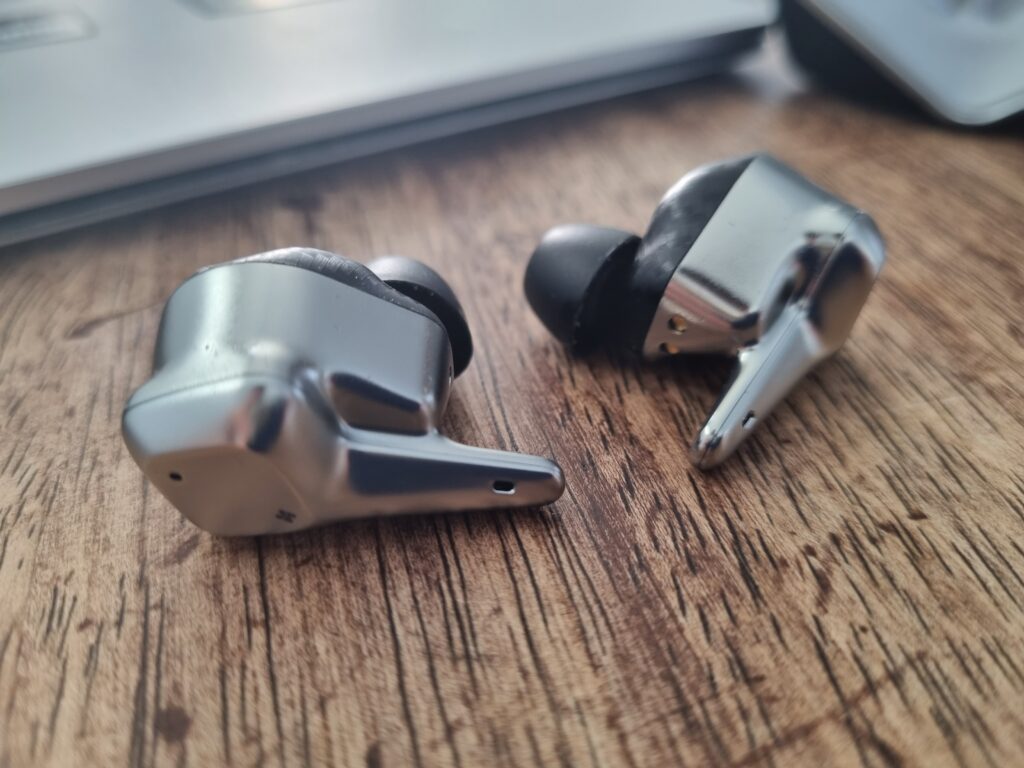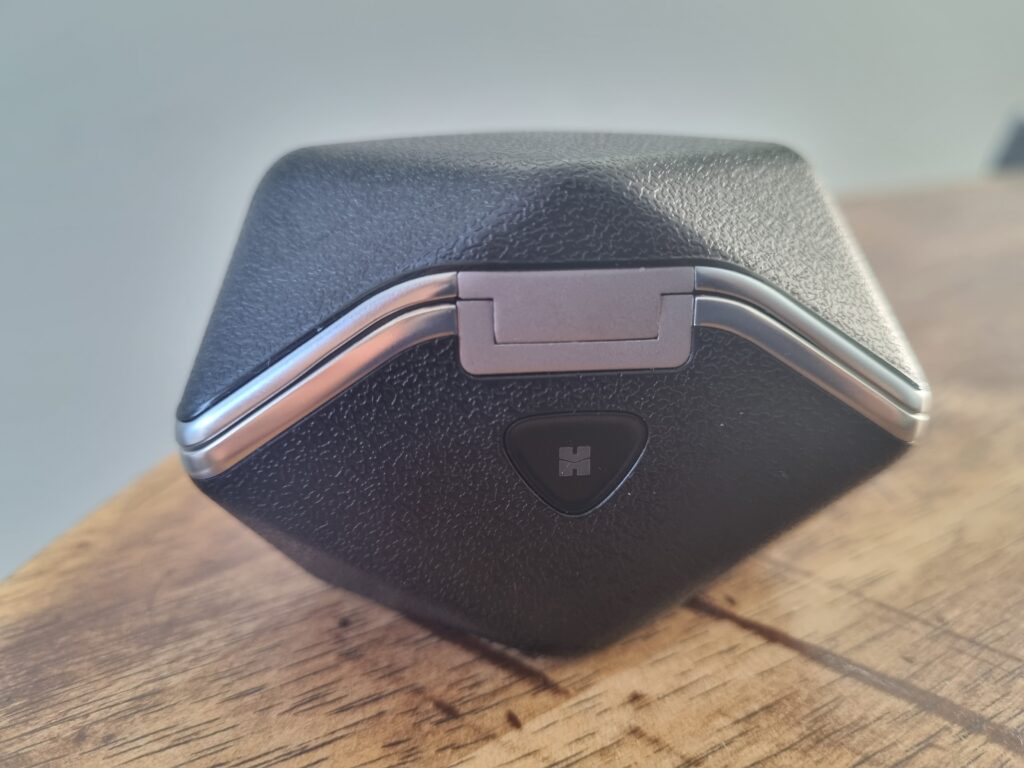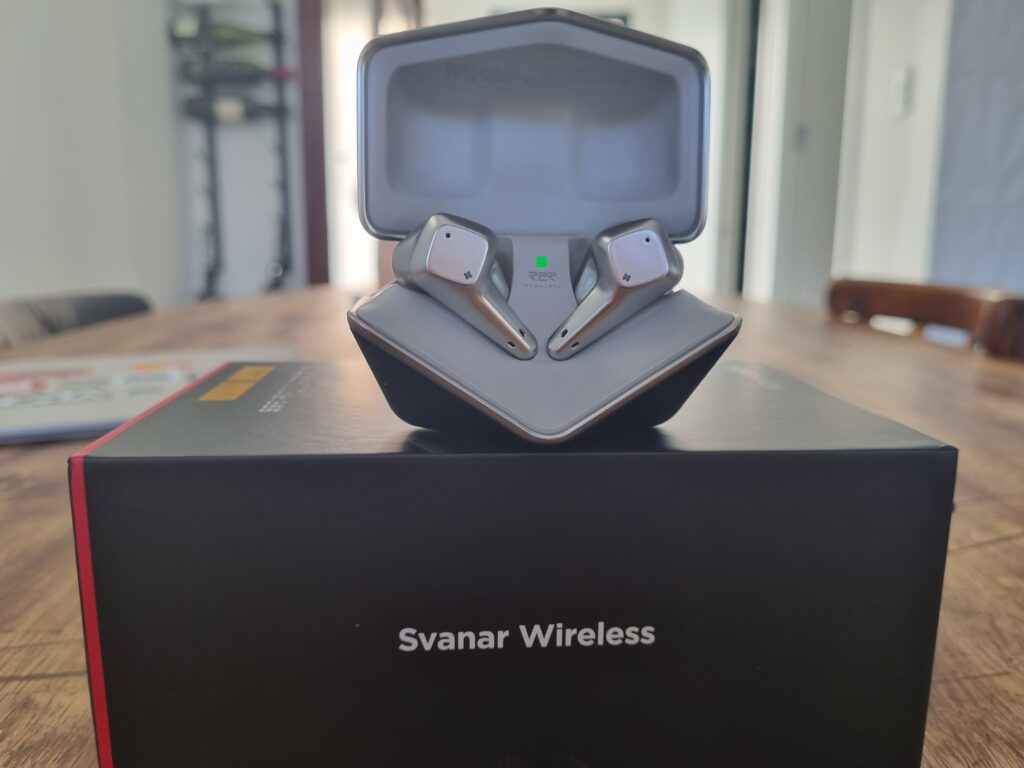TONALITY: 8.5/10
TECHNICALITIES: 8.2/10
TIMBRE: 8.2/10
SOUNDSTAGE: 9/10
IMAGING: 8/10
CONNECTIVITY: 6.5/10
CONSTRUCTION: 7.5/10
COMFORT: 8/10
CONTROL: 7/10
SOUND VALUE: VS TWS: 8.8/10 VS IEMS: 6.5/10
INTRO
Hifiman is a well established audio products company from China that have a wide range of products release including Planar headphones, DAP, DAC-AMP, IEMs and TWS Earbuds.
They have patented R2R DAC-AMP as well, which was use with their Deva Pro headphones as well as the Svanar Wireless I will review today.
Priced 500$, the Svanar Wireless is a flaghip TWS buds using R2R DAC-AMP and promising excellent sound quality as well as loud and dynamic rendering. Like most Hifiman IEMs, it use the Topology diaphram technology too.
Let see in this review what I will conclude about these luxurious TWS IEMs.
CONSTRUCTION
Like everybody seing the products pictures, I was expecting the Svanar TWS to be made of light alluminium alloy, but it's all plastic, front part seem different part of more high quality plastic. Overall shell is big and chunky but have an ergonomic share and is quite light, so with the right (non included) eartips and shallow fit I find it comfortable even for long listening session. Why shallow fit is mandatory? Because the nozzle is very short.
Desigh aesthetic isn't the most beautiful too, at least based on reaction from friends and family which find it weird looking. Personally it's more the big bulbous size that puzzle me, but this indeed permit to expend soundstage it seem.
The waterproof rating of these is IPX5, which mean you can wear it under the rain. I did it, no damage to be report.
The charging case is most luxurious looking part of the Svanar TWS, it's a bit heavy and don't fit well in pocket but have a sturdy elegant built. My qualm about this is that sometime the buds don't fit perfectly for proper charging.
Packaging is very minimalist, nothing to write really. Accessories is about 5 pairs of silicone eartips and 2 pairs of memory foams ear tips. As well as basic USB to USBC charging cable.
CONTROL
The control is enough minimalist to not be confusing, but not always up there in term of proper working.
I mean, everything work well most of time but it does happen that you take out the Svanar and touch pad dont work, you then need to put them back in and so forth.
It can happen only one buds will connect, you then need to do same thing.
It can be problematic when issue happen on the go and you dont have the charging carrying case to reset connectivity properly too, for ex, when you hold 3 sec the touch pad, it switch to Noise Cancelation, Transparency or Hifi mode, but it happen often it disconnect doing so.
When it does work, it's more intuitive than something like Final ZE8000 in term of proper touch pad sensitivity.
One press do Play/pause, 2 press go back song and 3 press next song. It's reactive 90% of the time.
Real issue is the ''disconnected'' surprise when you change mode when holding touch pad for 3 seconds as stated above.
SOUND MODE
ANC MODE
The noise cancelation is rather light but present. In fact, music play at lower volume than Hifi mode but we hear less outside noise than max volume of Hifi mode with music on so it does seem the 35db attenuation is legit....but I dont think it worth the leaner dynamic less musicality it deliver.
TRANSPARENCY MODE
Compared to Hifi mode, we here more outside noise, so the mic do add outside noise awareness, but here at max volume it play louder than ANC mode too...dynamic is better and this mode is quite usefull for at work.
HIFI MODE
Only worthy mode sound quality wise in my opinion, yet, Ldac issue make it sometime frustrating. Anyway, whole sound experience become more dynamic, open, full bodied and holographic, timbre is less affected by digital noise artefact. As well, different between AAC-SBC and Ldac aren't night and day, yet very valuable for audiophile ears.
CONNECTIVITY
For me, this is where the Svanar Wireless show its ''Achilles heels'' and it would be lying not to say this very connectivity instability make me confirm I will never touch anymore earbuds for the rest of my Audiophile life. Well, with the above control weakness combined, which is in fact quite common with most TWS buds too. But perhaps not as frustrating.
So, listening to Ldac outdoor in a city is just plain impossible with these, it will have invasise intermitence and noise cutting, whatever you got your phone in front of these it will not be trustable. One intermittence and whole music track immersivity is kill for me so let say i swear alot walking with those with Ldac.
Buuuuuuuut! If you clost wifi it can slightly improve it, i try these with 3 different phone and it behavior differently, nonetheless, ive never been spoil with perfect connectivity on the go with Ldac, just never.
Then if you go SBC (+wifi off), connectivity issue is solved and the sound quality isn't disastrous, think about going from Flac to MP3, it's about what you get here, slightly less clean and edgy resolution, more noisy background but as open and holographic soundstage and overall similar dynamic and tonality.
But you don't pay 500$ for low bitrate codec.
While at home or in deep forest, connectivity improve with Ldac. Another reason to run away from city!
BATTERY LIFE
At about 70% of volume, using Ldac with Hifi mode i can get about 4H single charge, so with 3 extra charge we can expect about 16H of autonomy, which is quite good.
SOUND IMPRESSIONS
(all sound impressions are made with Ldac using High Fidelity mode)
The overall Svanar TWS tonality can be summarize as gently bright and bassy W shape, with a smooth balance, warm punch slam, lush mids and extended, crunchy and snappy treble.
The first thing that impress listener is the rich macro dynamic which is lively, heavy in note weight and holographic in it's presentation. The spatiality is the highlight here, Svanar offering most gigantic soundstage of all TWS IEMs i've try as well as most sub-500$ cable IEMs too.
It trigger an engaging and immersive musicality where it's easy to get lost.
It's evident too that Svanar take full advantage of it's R2R DAC-AMP which permit unreachable technical performance I will try to devlop a bit more here.
But let's begin with the bass, which isn't lacking both in mid bass slam and sub bass wide headroom resonance and rumble.
We are in warm bass territory that slip and boost the lower mids range frequencies in a liquid natural way, keeping a tactile sens of sepration in layering but not being perfectly define in separation.
The physical impact and tone fullness is more focus than timing in attack edge which is a bit colored by sub bass warmth.
Bass line are not the easiest to follow due to this, but the slam headroom is stretched, vast and euphonic in a very addictive way.
Kick drum is warm, round and chunky with good note weight, While toms will have a bit too much resonance sustain for well define attack lead.
It seem prime goal of lower end is to cover whole fundamental frequencies which permit to all tenor instrument to sound fully restitute, cello sound vibrant, lush and dense is attack while the double bass sound natural too, not detached in term of texture and tone.
Yes, the low end is quite colored here, it's far from lean and neutral and the sub bass extension isn't reaching down to 20hz, but the acoustic resonance mimic the rumble lenght and it does work even if it affect proper attack control, so don't expect tightest bass response, the Svanar TWS low end is more appropriate for pop, soul, classical, slow jazz, folk, rap and R&B than fast hard hitting music like metal, some jazz, some rock.
The mid range sit between bright and lush, with an open holographic layering, full lower mids and impressive note weight. It's really best of both world when it come to hifiman since the timbre is on the thick natural side but well textured and the presence is well rounded and bodied.
Both male and female vocal are fowards sounding yet not sibilant, shouty or overly boosted in presence grain, thus the lushness terminology, we can say creamy with hint of pepper but i will fall in gastronomic terminology too much perhaps.
What is impressive is the good technical performance of this mid range since sound layers are plenty and multi layered within a vast and hefty macro dynamic 3 D rendering.
The transparency is good too, so contrast of those sound layers don't mix up and keep their singular loudness amplitude in a lively and cohesive way.
I can't say it's cleanest mid range though since the bass do stole background air clarity for proper instruments spacing crispness.
Yet it's not thin nor cold nor dry in term of timbre, its quite natural and excell with vocal and woodwinds instrument.
Piano too sound wonderfull, softed in presence texture with well felt and extended note weight and attack, no presence grain to be find and no lean dynamic here.
Finally, violin lack a bit of attack lead bite and proper definition of it's presence, but tone is right, and rendering isn't thin nor shouty.
Then the treble is open, crunchy and snappy. We don't struggle following percussions line which are fast and edgy enough in rendering. We aren't in dark treble here and level of micro details are quite good even if it's not analytical way.
To my ears, it's more evident to spot the Bluetooth limitation in treble area, in the sens that for me clarity is about how clean and well resolve are high pitch instrument and micro details, I can't overseen that silence have noise with all bluetooth IEMs i have try and those Svanar are no exception even if dynamic amplitude permit to avoid this background noise to mix with the fine details and instruments definition and layering.
So the highs are full sounding, never thin, they don't lack in edge even if their hint of euphonic delimitation to micro details of definition.
Cymbals sustain release are fully blossom but not the most brilliant in extension, splash cymbals are a bit tamed in amplitude freedom, so it's not splashy but not crisp either.
I'm not sure to understand how the highs sound so open but their something about slight extra sparkle here, not in far upper treble region but the metallic snap is there with pulled string.
The Soundstage is main star of the show for me, its very wide and tall with decent depth too. It sound very out of your head, you feel you bring a whole room with you. Their no doubt its the biggest spatiality rendering I've heard with any high end earbuds.
Then it should mean the imaging excellent, which it is in TWS realm, but it's mostly about the dynamic rendering of each sound layer that permit good holographic separation in Y axis. For more static and less loud instrument, it will suffer from lack of clean separation in X axis. Nonetheless, its very very good instrument positioning perception.
COMPARISONS
VS FINAL ZE8000
The ZE8000 sound more neutral to L shape, warmer and have more sub bass boost and warmth that permit heavier note weight, thicker but creamier timbre and overall more natural timbre.
The dynamic is more laid back, resolution is darker but more liquid and organic than edgier resolution of Svanar, that offer a more W shape and punchy signature.
Bass separation is inferior and more bleedy than Svanar, its mellower in punch, its slightly thicker in term of bass to lower mids transition, it's slower and not very textured compared to Svanar too.
Mids feel leaner, and a bit more recessed both male and female vocal wise in term of plain presence boost but thisn presence is more bodied, have more lower harmonic balance and lushness, never sibilance will occur so it's smoother more butter yet less open, crisp, clean, detailed and well resolved than Svanar which have greater upper mids gain, more precise imaging and vaster sound layering capability.
Treble is edgier, crunchier and more sparkly too with the Svanar, ZE8000 offer a thicker softer treble with smoothed brilliance and very relaxed dynamic, it's not very textured nor very clean in definition, it does lack air on top compared to Svanar too, as well as fast attack control and clean decay.
Soundstage is way more tall, wide and deep with the Svanar, no comparison here.
Imaging is less foggy as a whole and sharper in each instrument definition with wider spacing between them with the Svanar, again, no competition.
All in all, while neutral in overall balance, the bass and lower mids coloring is quite intense with the ZE8000, it's evident than te technical peformance like imaging, soundstage, attack speed-control and resolution are extremely inferior to the Svanar, yet for tone and timbre lower only as well as vocal lover, the ZE8000 might win their hearth. I doesn't win mine though.
VS Unique Melody Ufree :
Now in term of technical competition, we have a closer match though it's all about the Bone conduction driver part of UM sound rendering which doesn't sound as lush, cohesive and natural as Svanar more dynamic rendering.
In term of macro dynamic rendering, UM feel more compressed and in your head, less open and airy than Svanar.
The bass isn't as round and heavy hitting as Svanar, it doesn't have alot of air in term of rumble, it's dryer with more boosted texture and presence. Lower extension is more natural and deep and vibrant with the Svanar, mid bass punch is a hint warmer but still more tactile and meaty than UM.
Mids are less lean and bright and boosted in texture presence than UM, vocal are more wide and open, less stock in your head and compressed, timbre is lusher too, not as bright in texture, overal mid range is more compressed, lean and artificial with the UM.
Treble is dryer and less crisp and sparkly with the UM, the dynamic feel again compressed, less airy open and free in natural decay than Svanar.
Soundstage is stock in your head way more with UM and less holographic, wide and deep.
Imaging lack proper space between both X axis instrument separation and Y axis sound layers separation with the UM.
All in all, Svanar is both superior in technicalities and tonal balanced, as well as timbre and tone naturalness and ultimately musicality: wich the UM crually lack.
VS HIFIMAN SVANAR+iFi GO POD (2400$ TWS DUO)
It most be noted here that I was puzzled to compare a TWS to cabled IEM with mid or high end source, so to be fair i downscale the Svanar with best TWS dac-amp out there. WHy down scale? Cause Svanar are 60ohm of impedance and benefit more than 120mw@32ohm amping.…
Nonetheless, it's evident technical performance like clarity, attack control, imaging accuracy, fine micro details and everything but soundstage is better with OG Svanar.
Yes, the TWS have bigger soundstage, which underline the benefit of R2R DAC-AMP, which i dynamic gain is superior to Go Pod, at least, for the very Svanar driver…
Tonality is near identical, but OG Svanar offer a more balanced W shape, hint less warm and bassy, we don't have as much sub bass resonance warmth in low end so the bass is more textured, better define in mid bass for kick drum presence and tighter-faster in attack control, which mean it's better separated from mid range too.
OG Svanar mids are cleaner, better resolved, edgier in definition and more transparent yet richer in texture info too. For ex, piano note are less warm and have longer cleaner natural decay. It seem upper mids are less smoothen and hint brighter too, female vocal aren't as lush and wide in presence than the TWS but they are better extracted and layered, less softed in definition edge. Overall mids are less colored and thick than TWS too.
Treble is more snappy and sparkly, percussions are easier to follow and level of macro and micro sound info are all superior with OG Svanar. Overall treble is cleaner, less softed in sustain-release.
Svanar TWS soundstage is taller and wider but not as deep since clarity isn't as sharp and clean, silence being more ''noisy''.
Imaging while less holographic is notably more accurate, precise and sharp with OG Svanar.
All in all, the Svanar TWS isn't far of OG Svanar tonality but technical performance can't compete with them, especially if we use high end source, but with something entry level like GO POD, the Svanar TWS surpass OG Svanar in term of spatiality and offer a more holographic and immersive musicality, with warmer but fuller tone and overall more pleasant performance even if not as technical.
CONCLUSION
The Svanar Wireless barely make me change my mind about TWS IEMs in general, I mean, it does in term of plain sound quality that can challenge cabled IEMs, but not in 500$ price range, more in 200$ and lower price range if connected to a good source.
Since i'm a passionate being, if something annoy me, it tend to ruin whole enjoyement experience and the Ldac connectivity issue was a very big drawback for me as well as random plain disconnection on the go if I change mode.
So, did the Svanar TWS are thinked for sedantary use? Well, with nowadays 4G and 5G wifi invading every space, I do think TWS is even more risky than before to buy if you live in a city or even a small village like me. If you live in forest....I guess it can be OK, but at they end it can be solve using AAC or SBC codec.
On the positive side: the Svanar Wireless are the very best sounding TWS buds i've ever heard, with the most dynamic and holographic rendering, beautiful mids and airy treble, and a warm slam that make my head bang more than one time.
Will i recommend this for serious audiophile? Nope.
But hey: Highly recommended for TWS lover!
-------------------------------------------
PS: I want to thanks Hifiman for sending me this review sample. As always, those are my 100% independant minded audio impressions.
You can order the Svanar Wireless for 500$ directly from official Hifiman store here:
https://store.hifiman.com/index.php/svanar-wireless.html






















